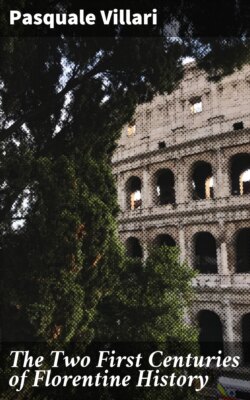Читать книгу The Two First Centuries of Florentine History - Pasquale Villari - Страница 9
На сайте Литреса книга снята с продажи.
ОглавлениеETRUSCAN TOMBSTONES, FROM THE MERCATO VECCHIO, FLORENCE.
But in these days the study of mediæval documents has made extraordinary progress, above all in Germany, and accordingly the Florentine question has been again reopened. Dr. O. Hartwig was the first to apply his learning to the task, employing the scientific method. He not only examined all that was published on the subject, but made fresh researches in Italian libraries and archives, further aided by precious notes of documents newly discovered in Tuscany by D. Wüstenfeld. Thus, in the work from which we have frequently quoted, he was enabled to give a collection of valuable documents and of learned dissertations which have been already turned to account, will serve as a basis for future researches, and would be still better known and appreciated were they penned in a more popular style. Much has been found, very much read by Prof. Perrens, who has devoted his life to Florentine history, and already published eight volumes of his work. His first volume, of five hundred pages, only extends to the middle of the thirteenth century, and therefore treats of the origin of the city learnedly and at length. All Italians owe him gratitude for this; but it must be confessed that his untiring zeal, vast learning, and prodigious reading have not always resulted in a due amount of historical accuracy, and sureness of method. Treating of a period in which all has to be built up on a very scanty number of known facts, unless these facts are thoroughly ascertained disastrous consequences are apt to ensue. For example, in investigating the first origin of the Consuls, he still relies on the document of Pogna, dated March 4, 1101, in which they are named, and without remarking that Capponi, from whom, nevertheless, he continually quotes, had proved that, although long thought correct, this date was erroneous, and should be altered to March 4, 1181, Florentine style, the which signifies 1182 in the modern style. Thus Prof. Perrens introduces Consuls long before they were born.45 Elsewhere he plunges into the very intricate dispute as to the jurisdiction exercised over their own territory by the Florentines of the twelfth century. He repeats with the old chroniclers that in 1186 Frederic I. deprived them of all jurisdiction beyond the city walls, but that they re-acquired it in 1188. He adds that on the Emperor Frederic's decease in 1190, his successor, Henry VI. "comme don de joyeux evènement, multiplie les privilèges." He fails to reflect that the patent quoted in support of the latter assertion bears the date of 1187, and that he gives the date in a note of his own.46 How is the reader to disentangle this skein? As another example, we may add that the author gives as an historical fact the legendary tale of the origin of the Colombina festival held on Holy Saturday. The Florentines are sent to the Crusades by their archbishop, Ranieri, in 1099: that is several centuries before Florence possessed an archbishop. Pazzino de Pazzi, in reward for his feats of valour at the taking of Jerusalem, receives the mural crown from Godfrey de Bouillon, together with the right to change his arms and adopt the crosses and dolphins, the which change was only effected by the Pazzi several centuries later.47 Pazzino returns to Florence in triumph, mounted on a car, of which the description is given; and at a time when the Commune was not yet established,48 is received in the style of a Roman conqueror by the people, the clergy, and the magistrates. He has brought three stones from the Holy Sepulchre, and these are the flints from which the sparks are still struck to fire the Car of the Dove. All this is derived from Gamurrini's "Storia genealogica," an utterly valueless work.49 Readers may consider it strangely invidious on my part to be at the pains to refer to certain blunders contained in a work of which I am the first to recognise the merits, and by which I have often profited. But it seemed necessary to explain why, in spite of having praised, I should so seldom quote it. The work undeniably comprises abundant historic material, is written with vivacity and clearness, contains many keen observations, and does honour to an author to whom Italians are bound to be grateful. But although for all these reasons it is a book deserving attention, no possible use can be made of it, without continually verifying the authorities cited in it.
Here a word must be said touching another and far less imposing work, to which we have been able to refer with far greater security. Already, in certain short papers appearing in the "Archivio Storico Italiano," Prof. Santini had proved his power of keen research on the early history of Florence, and has now had the happy idea of collecting all the documents on the subject, both published and unpublished, existing in the Florentine Archives. After copying and verifying them from the originals, he is now bringing them out in a bulky volume. It would be well if he or other writers could complete the same task in all cities, or at least in those of Tuscany, which had so many ties in common. Meanwhile, his book will form a new and solid foundation for Florentine historic research. We are doubly grateful for his kindness in allowing us to examine his press proofs. Thus we have been enabled to profit by his forthcoming book in advance of its publication, and shall have frequent occasion to quote from it. Other works, unmentioned in the text, will be recorded in the notes for our readers' benefit.
SITE OF A ROMAN VILLA DISCOVERED NEAR S. ANDREA, FLORENCE.
